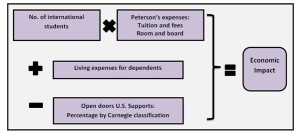Impact of International Education on U.S. Economy
The purpose of this article is to acknowledge the impact and the potential benefits of international education to the U.S. economy. It is being noted that there is a significant growth in the foreign students to the U.S. for the purposes of senior secondary and higher education institutions. International students contributed billions to the U.S. economy. Furthermore, in 2015 student contribution was about 30.5 billion dollars to the U.S. economy, in 2014 it was about 27 billion dollars and in 2013 contribution was about 24 billion dollars to the U.S. economy. Enormous shift has been brought up by the students from upper – middle income level in the economies.
The basic meaning of economic impact is the amount which is being brought up by the foreign students in the united states to atone for their education fees and to support themselves (and in some cases, their families) while they stay in the United States as a student. The objective of the formula for computing impact on the economy is the analysis of the data from the data which is being already stored for other purposes. Furthermore, the data provide a reasonable estimation of economic resources that will be imported by foreign students to the United States in support to themselves and for their educational purposes.

Make My Assignments|Assignment help make customized assignments. Our team of experts is ready to make your assignments 24×7. We provide 100% Plagiarism free work
Since 2000, methodology for computation of economic impact has been greatly redefined over a period of the last three decades. In order to computation of expenses we adhere living expenses, cost of tuition, fees from data collected from surveys under Peterson’s. This data is being completed by different institutions every year. The calculations are not only sensitive to different costs of institutions, but also sensitive in determining the differing costs for graduate students, undergraduate students and students with practical training.
Need help with assignments? Get the best assignment help service from MakeMyAssignments.com
The data sets adhered to be analyzed comes from the following two sources:
- Peterson provides cost analyzed figures for living, tuition, and miscellaneous expenses at United States institutions for the academic year. In some earlier years, this information was available from the College Board.
- The Institute of International Education annual Open Doors report, is being financed by the Department of State, provides various opportunities to the number of foreign students at universities and colleges throughout the United State during the academic year.
The economic impact of international students in the U.S. economy amounts equals to tuition fees, plus miscellaneous cost of 50% of room and board, plus room and board and less U.S. support. Furthermore, here we are assuming that the spring enrollment figures are the same as of figures which are being reported to the institutions. All the students are being enrolled for all the two semesters or three quarters in a year, and also the international students live on campus for the whole year. According to the survey, the miscellaneous expenses are being enumerated of average about 40 % of board and room expenses. Also, approximately 50% figure includes all the extra expenses in exception to travelling expenses.
In order to evaluation of the impact of international students on the United States economy, we can also understand the impact on the cost and benefits of the impact for the same which are being explained as follows:
- The net benefits of time streams – This comprises an analysis of the flowing streams of financial or other different benefits to the institutions. These are also bestowing to the programs of the institutions. Also, net of any recurrent cost has never been accounted for, and is mounted over the life of the program.
- Cost of infrastructure establishment–It enables to cover the administrative cost, operating systems in support to ongoing program, setting up of a course program servicing particularly for the students. Furthermore, the enormous earning from the sector of international education of the foreign students can be used by the United States in the betterment and advanced infrastructure.
- Program delivery cost– These comprise the recurrent cost of delivery of services provided by the program over the period of the course life. Whereas in some cases, a program is uniquely devoted to international objectives, then in such case, cost of core activity is being charged and all other cost are being excluded.
The main impact which is being showcased in these programs the export dollars are being brought up in the United States economy by different institutions, state, and the overall U.S. economy which are being tracked. It also helps politician to provide a political argument in support of international education as it is very vital for the United States economy in the long run. However, the U.S. is losing enormous benefits due to some immigration barriers. After completing studies students have to remain engaged in providing services the same country after completing their degrees or mastery this is one of a kind of immigration barrier. The United States should overcome such barriers, which will lead to more entrance of foreign students in the international education program, at the end, entitling more growth and revenue generation in the U.S. economy.


